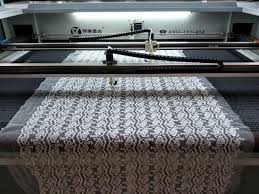Textile Laser Cutting Machine: Revolutionizing Fabric Industry
In the fast-paced world of textile manufacturing, precision and efficiency are key factors in staying competitive. The introduction of textile laser cutting machines has revolutionized the fabric industry, offering a range of benefits that traditional cutting methods simply cannot match.
Textile laser cutting machines utilize advanced laser technology to precisely cut through various types of fabrics with unparalleled accuracy. From delicate silk to tough denim, these machines can handle a wide range of materials with ease, producing clean and precise cuts every time.
One of the major advantages of using a textile laser cutting machine is its versatility. Unlike traditional cutting methods that require different tools for different fabrics, a laser cutting machine can seamlessly switch between materials without the need for manual adjustments. This not only saves time but also reduces material waste, making it a cost-effective solution for fabric manufacturers.
Furthermore, textile laser cutting machines offer intricate design capabilities that were previously impossible with conventional cutting techniques. Complex patterns, intricate details, and fine edges can be achieved with precision and consistency, allowing designers to unleash their creativity without limitations.
Another significant benefit of using a textile laser cutting machine is its speed and efficiency. These machines can cut through fabrics at high speeds without compromising on quality, significantly increasing production output and reducing lead times. This is especially crucial in industries where quick turnaround times are essential.
Overall, textile laser cutting machines have transformed the fabric industry by providing manufacturers with a reliable, efficient, and precise cutting solution. As technology continues to advance, we can expect further innovations in this field that will continue to push the boundaries of what’s possible in textile manufacturing.
Top 5 FAQs About Textile Laser Cutting Machines: Functionality, Fabric Compatibility, Benefits, Usability, and Maintenance
- 1. How does a textile laser cutting machine work?
- 2. What types of fabrics can be cut using a textile laser cutting machine?
- 3. What are the key advantages of using a textile laser cutting machine over traditional cutting methods?
- 4. Are textile laser cutting machines user-friendly and easy to operate?
- 5. What maintenance is required for a textile laser cutting machine?
1. How does a textile laser cutting machine work?
A textile laser cutting machine operates by harnessing the power of focused laser beams to precisely cut through various types of fabrics. The process begins with the design being inputted into the machine’s software, specifying the desired pattern or shape to be cut. The laser beam is then directed onto the fabric surface, where it heats and vaporizes the material along the designated cutting path. This results in clean, precise cuts without any fraying or distortion of the fabric edges. The speed and intensity of the laser can be adjusted based on the fabric type and thickness, allowing for customization and flexibility in cutting different materials. Overall, textile laser cutting machines offer a highly efficient and accurate cutting solution that has revolutionized the fabric industry.
2. What types of fabrics can be cut using a textile laser cutting machine?
A textile laser cutting machine is incredibly versatile and can cut through a wide range of fabrics with precision and ease. From delicate materials like silk and chiffon to more robust fabrics such as denim and leather, textile laser cutting machines are capable of handling various types of textiles. Whether you’re working with natural fibers, synthetic materials, or blends, these machines offer the flexibility to cut through different fabrics without compromising on quality, making them a valuable tool for fabric manufacturers across different industries.
3. What are the key advantages of using a textile laser cutting machine over traditional cutting methods?
When considering the key advantages of using a textile laser cutting machine over traditional cutting methods, several factors come into play. Firstly, the precision and accuracy offered by a textile laser cutting machine are unparalleled, ensuring clean and consistent cuts across a wide range of fabrics. Additionally, the versatility of these machines allows for seamless transitions between different materials without the need for manual adjustments, saving both time and reducing material waste. Furthermore, the speed and efficiency of textile laser cutting machines significantly boost production output and streamline manufacturing processes, making them a cost-effective and innovative solution for fabric manufacturers seeking to stay ahead in a competitive industry.
4. Are textile laser cutting machines user-friendly and easy to operate?
When it comes to textile laser cutting machines, a frequently asked question is whether they are user-friendly and easy to operate. The answer is a resounding yes. Textile laser cutting machines are designed with user convenience in mind, featuring intuitive interfaces and user-friendly controls that make operation straightforward for both beginners and experienced users alike. With minimal training, operators can quickly learn how to set up the machine, input cutting parameters, and start the cutting process efficiently. Additionally, many manufacturers provide comprehensive user manuals and technical support to ensure that customers have all the resources they need to operate their textile laser cutting machines effectively.
5. What maintenance is required for a textile laser cutting machine?
Maintenance is a crucial aspect of ensuring optimal performance and longevity of a textile laser cutting machine. Regular maintenance tasks for these machines typically include cleaning the lenses and mirrors to prevent dust buildup, checking and adjusting the alignment of the laser beam, inspecting and replacing worn parts such as belts and filters, and ensuring proper ventilation for effective cooling. Additionally, it is important to follow the manufacturer’s guidelines for maintenance schedules and procedures to keep the machine running smoothly and to avoid costly downtime due to unexpected issues. By staying proactive with maintenance, fabric manufacturers can maximize the efficiency and lifespan of their textile laser cutting machines.

No Responses